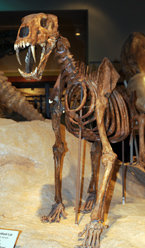Highlights of Paleontology at UT Austin
March 24, 2011

- 2008: Early hominid Lucy CT-scanned
- 2001: Fossil fetus of an Elephant bird CT-scanned and reconstructed without breaking egg shell
- 1999: Non-vertebrate Paleontology Lab established
- 1997: High Resolution XRay CT Lab founded
- 1994: FAUNMAP, database of North American mammals for the last 40,000 years (E. Lundelius)
- 1971: Discovery of the largest known flying animal, Quetzalcoatlus, in Big Bend (D. Lawson)
- 1950: H.B. Stenzel produces reports on the Stone City fauna and the evolution of the gastropod Athleta petrosa
- 1949-1951: Discovery of nearly complete scimitar-toothed cat in Friesenhahn Cave (Evans, Mead, et al.)
- 1949: Vertebrate Paleontology Laboratory (VPL) established
- 1939-42: WPA project collects fossils for UT from 22 Texas counties
- 1939: Texas Memorial Museum opens
- 1915: First micropaleontology course (one of two earliest in U.S.) taught at UT (F.L. Whitney)
- 1909: First paleontology course taught at UT (F.L. Whitney)
- 1888-94: Dumble Survey assembles first significant paleontological collection in Texas
>>> Return to “Enduring Excellence”
For more information about the Jackson School contact J.B. Bird at jbird@jsg.utexas.edu, 512-232-9623.
